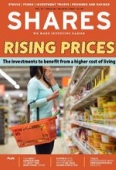Archived article
Please note that tax, investment, pension and ISA rules can change and the information and any views contained in this article may now be inaccurate.
Why value shares win when interest rates rise

Since the first successful vaccines were announced in November 2020 value shares have made a huge comeback after many years in the wilderness.
You may have wondered why value shares have continued to perform well this year on expectations of rising interest rates. In this article we explain how rising rates impact value and growth shares using a concept that is more often used in the bond world, namely duration.
SHORT DURATION VS LONG DURATION
In short, value shares are considered short duration and growth shares are considered long duration. As any bond fund manager will tell you, when interest rates rise, you want to make sure you lower a portfolio’s duration.
That’s because longer dated bonds are more sensitive to changes in interest rates. For example, a portfolio with a 10-year duration is expected to fall 10% for every 1% increase in rates while a three-year duration portfolio will only fall 3%.
Just remember the rule of thumb, a 1% change in interest rates will affect bond prices by 1% in the opposite direction (an increase of 1% will push prices lower) for every year of duration.
The popularity of value shares in favour of growth shares has in large part been down to rising interest rates.
The traditional way to value shares is to apply discounted cash flow techniques which are very sensitive to the risk-free rate of interest.
If rates increase, it affects the companies which have a stronger growth profile more than those with modest growth.
This is a better way to think about value and growth, after all, in a classic sense everyone should be a value investor.
Higher growth shares can be undervalued relative to their growth while low growth value shares can be overvalued if they disappoint.
A BIRD IN THE HAND
It comes down to what famed investor Warren Buffet called a bird in the hand versus three birds in the bush.
Companies that have lower growth opportunities tend to pay out more of their earnings as dividends, while companies with big growth opportunities reinvest back into the business.
There is no guarantee that the investment will pay off, but if it does, the results can be very rewarding. But, the crucial point to recognise is that growth investors are betting that birds in the bush are worth a lot more than the one in the hand.
Conversely value investors are more comfortable with a bird in the hand and getting paid regular dividends.
If you think about the dividend as the equivalent of the coupon (interest paid) in the bond world, the similarities become clearer and the role of duration starts to make sense.
Companies where more of the total return (capital gain plus dividend) is composed of dividends have lower duration because investors get regular income payments which reduces their original cost of investment.
If we know the expected growth rate of the dividend, we can calculate the amount of time it takes to recoup the initial investment and calculate an implied duration.
We can’t use this type of analysis for companies that either don’t pay dividends or dole out relatively small amounts.

A low duration example is tobacco company Imperial Brands (IMB), where investors pay nine times the 138p dividend per share, representing a dividend yield of 9.4% based on a share price of £14.76.
The dividend has been reduced over the last few years, so we have assumed it will continue to fall around 5% a year. Investors buying at today’s price and holding for 11 years would recoup their original investment, implying a duration of 11 years.

A higher duration example is international distribution company Bunzl (BNZL) where investors pay 45 times last year’s dividend of 54.1 pence per share.
Assuming Bunzl can grow its dividend at the same 7% rate as the last few years, it would take 20 years for investors to recoup their original investment, implying a duration of 20 years.
RANKING STOCKS BY SENSITIVITY TO RATES
By calculating the implied durations of stocks in this way we can rank them according to their sensitivity to changes in interest rates, bearing in mind that other factors, such as level of indebtedness will also impact sensitivity to rates.
It should also be noted that Bunzl may ultimately provide a higher total return for investors over the long run than Imperial Brands, but the longer duration of Bunzl makes the shares more sensitive to changes in interest rates.
In other words, sensitivity to interest rates is just one of many inputs that investors need to consider when weighing up the risks and rewards.
Low duration

M&G (MNG) 210.1p
Fund manager M&G (MNG) has a diversified business with around 5.5m retail clients and over 800 institutional clients, contributing to assets under management of £367.2 billion.
The distribution platform is global and serves 28 markets from 20 offices.
The shares trade on nine times 2021 expected earnings while the dividend of 18.1 pence per share (down from 18.2 pence last year) provides a yield of 8.6% which is well covered by earnings.
The implied duration of the shares at current levels mean that investors will recoup their investment in 11.6 years, assuming the dividend is held at the same level. There is scope for it to grow over time, reducing duration.
Low duration and implied growth suggest investors have become too pessimistic on the prospects of the business, despite the shares recently hitting 12-month highs.
The company said recently that cash levels had surpassed 20% which would allow the manager to meet redemptions.
High duration

Sthree (STEM) 396p
Recruitment firm Sthree (STEM) is poised to benefit from the economic upturn that economists expect this year as vaccinations programmes are rolled-out across the globe.
That’s because the firm is focused on Contract as apposed to Permanent staffing which makes up less than 20% of fee income.
New chief executive Mark Dorman believes the opportunity for specialist recruiters in the science, technology, engineering and mathematics fields is ‘both enormous and growing’ and the company is uniquely positioned to benefit among the listed staffing firms.
The dividend is expected by analysts to grow to 9.44 pence per share in 2021 from five pence last year, which we have used as the base. If we assume the dividend can grow at 7% a year, the shares have an implied duration of 20 years. The company pays out around half of earnings in dividends.
Rising interest rates may act as a dampener on the valuation of the shares, but the higher expected growth should benefit long-term holders.
Important information:
These articles are provided by Shares magazine which is published by AJ Bell Media, a part of AJ Bell. Shares is not written by AJ Bell.
Shares is provided for your general information and use and is not a personal recommendation to invest. It is not intended to be relied upon by you in making or not making any investment decisions. The investments referred to in these articles will not be suitable for all investors. If in doubt please seek appropriate independent financial advice.
Investors acting on the information in these articles do so at their own risk and AJ Bell Media and its staff do not accept liability for losses suffered by investors as a result of their investment decisions.
Issue contents
Editor's View
Feature
- Help, I want to start saving for the future
- Rising prices: The investments to benefit from a higher cost of living
- Why value shares win when interest rates rise
- Ongoing uncertainty for commercial property stocks
- Emerging markets: Views from the experts
- Understanding China’s dominant but under pressure internet stars
Great Ideas
- Focusrite is up 75% in the last nine months
- Big upgrades for Morgan Sindall on bullish trading update
- Anglo American is an attractive play on electric vehicle and renewables transition
- Exit Anexo which has gone nowhere on positive news
- Buy payments challenger Equals as it passes the 2020 test
- RWS merger continues to pay off in spades

 magazine
magazine








